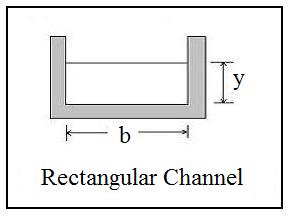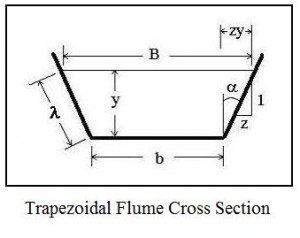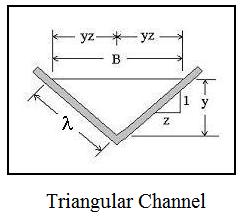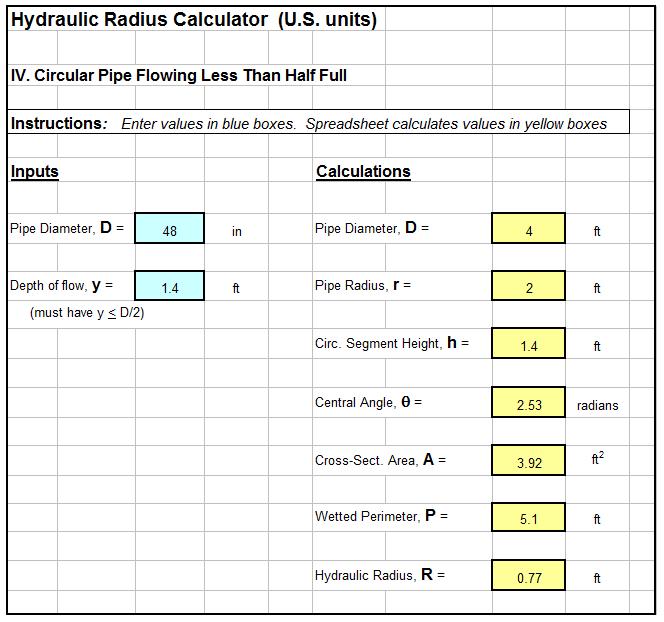Where to Find Spreadsheets for Hydraulic Radius Open Channel Flow Calculations
For an Excel spreadsheet to use for hydraulic radius open channel flow calculations, click here to visit our spreadsheet store. Read on for information about hydraulic radius open channel flow calculations.
The hydraulic radius is an important parameter for open channel flow calculations with the Manning Equation. Excel spreadsheets can be set up to conveniently make hydraulic radius open channel flow calculations for flow through common open channel shapes like those for a rectangular, triangular or trapezoidal flume. Parameters like trapezoid area and perimeter and triangle area and perimeter are needed to calculate the hydraulic radius as described in the rest of this article.
The hydraulic radius for open channel flow is defined to be the cross sectional area of flow divided by the wetted perimeter. That is: R = A/P, where A is the cross sectional area of flow, P is the portion of the cross sectional perimeter that is wetted by the flow, and R is the hydraulic radius. The next several sections will present the equations to calculate A, P, and R for some common open channel shapes, and then discuss the use of Excel spreadsheets for hydraulic radius open channel flow calculations.
Hydraulic Radius Open Channel Flow Calculation for Rectangular Channels
 Rectangular channels are widely used for open channel flow, and hydraulic radius open channel flow calculations are quite straightforward for a rectangular cross section. The diagram at the left shows the depth of flow represented by the symbol, y, and the channel bottom width represented by the symbol, b. It is clear from the diagram that A = by and P = 2y + b. Thus the equation for the hydraulic radius is: R = by/(2y + b) for open channel flow through a rectangular cross section.
Rectangular channels are widely used for open channel flow, and hydraulic radius open channel flow calculations are quite straightforward for a rectangular cross section. The diagram at the left shows the depth of flow represented by the symbol, y, and the channel bottom width represented by the symbol, b. It is clear from the diagram that A = by and P = 2y + b. Thus the equation for the hydraulic radius is: R = by/(2y + b) for open channel flow through a rectangular cross section.
Hydraulic Radius Open Channel Flow Trapezoidal Flume Calculations
 The trapezoid is probably the most common shape for open channel flow. Many man-made open channels are trapezoidal flumes, including many urban storm water arroyos in the southwestern U.S. Also, many natural channels are approximately trapezoidal in cross section. The parameters typically used for the size and shape of a trapezoidal flume in hydraulic radius open channel flow calculations are shown in the diagram at the right. Those parameters, which are used to calculate the trapezoid area and wetted perimeter, are as follows:
The trapezoid is probably the most common shape for open channel flow. Many man-made open channels are trapezoidal flumes, including many urban storm water arroyos in the southwestern U.S. Also, many natural channels are approximately trapezoidal in cross section. The parameters typically used for the size and shape of a trapezoidal flume in hydraulic radius open channel flow calculations are shown in the diagram at the right. Those parameters, which are used to calculate the trapezoid area and wetted perimeter, are as follows:
- y is the liquid depth (ft for U.S. & m for S.I.)
- b is the bottom width of the channel (ft for U.S. & m for S.I.)
- B is the width of the liquid surface (ft for U.S. & m for S.I.)
- λ is the wetted length measured along the sloped side (ft for U.S. & m for S.I.)
- α is the angle of the sloped side from vertical. The side slope also often specified as horiz:vert = z:1.
The common formula for trapezoid area, A = y(b + B)/2, is a good starting point for obtaining a useful equation for A. It can be seen from the diagram that B = b + 2zy, so the trapezoid area can be expressed in terms y, b, and z: A = (y/2)(b + b + 2zy)
Simplifying gives: A = by + zy2.
The wetted perimeter can be expressed as: P = b + 2λ. The typically unknown sloped length, λ, can be eliminated using the Pythagoras Theorem:
λ2= y2+ (yz)2, or λ = [y2+ (yz)2]1/2 Thus the wetted perimeter is:
P = b + 2y(1 + z2)1/2, and the hydraulic radius for a trapezoid can be calculated from:
R = (by + zy2)/[b + 2y(1 + z2)1/2]
Hydraulic Radius Open Channel Flow Triangular Flume Calculations
 Another shape used in open channel flow is the triangular flume, as shown in the diagram at the right. The side slope is the same on both sides of the triangle in the diagram. This is often the case. The parameters used for hydraulic radius open channel flow calculations with a triangular flume are as follows:
Another shape used in open channel flow is the triangular flume, as shown in the diagram at the right. The side slope is the same on both sides of the triangle in the diagram. This is often the case. The parameters used for hydraulic radius open channel flow calculations with a triangular flume are as follows:
- B is the surface width of the liquid (ft for U.S. & m for S.I.)
- λ is the sloped length of the triangle side (ft for U.S. & m for S.I.)
- y is the liquid depth measured from the vertex of the triangle (ft for U.S. & m for S.I.)
- z is the side slope specification in the form: horiz:vert = z:1.
The common formula for triangle area is: A = By/2. As shown in the figure, however,
B = 2yz, so the triangle area simplifies to: A = y2z.
The wetted perimeter is: P = 2λ , but as with the trapezoidal flume: λ2= y2+ (yz)2.
This simplifies to the convenient equation: P = 2[y2(1 + z2)]1/2
The hydraulic radius is thus: RH= A/P = y2z/{2[y2(1 + z2)]1/2}
Excel Spreadsheets for Hydraulic Radius Open Channel Flow Calculations
With the equations given in the previous sections, the hydraulic radius can be calculated for a rectangular, triangular or trapezoidal flume if appropriate channel size/shape parameters are known along with the depth of flow. An Excel spreadsheet like the one shown in the image below, however, can make the the calculations very conveniently. Excel spreadsheets like the one shown below for use as hydraulic radius open channel flow calculators for rectangular, triangular, and trapezoidal flumes, as well as for partially full pipe flow, are available in our spreadsheet store.
References:
1. Bengtson, Harlan H., Open Channel Flow I – The Manning Equation and Uniform Flow, an online, continuing education course for PDH credit.
2. U.S. Dept. of the Interior, Bureau of Reclamation, 2001 revised, 1997 third edition, Water Measurement Manual.
3. Chow, V. T., Open Channel Hydraulics, New York: McGraw-Hill, 1959.
4. Bengtson, Harlan H., “The Manning Equation for Open Channel Flow Calculations,” available as an Amazon Kindle e-book and as a paperback.

